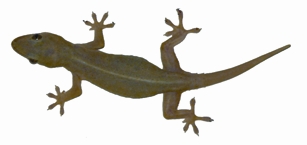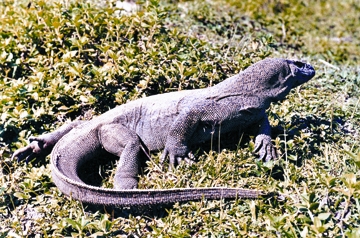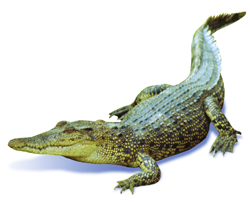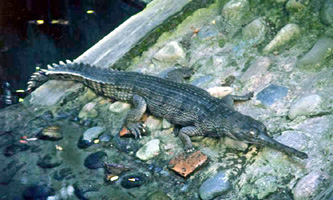Reptile
Reptile (sorisreep) cold-blooded vertebrates of the class Reptilia, which holds a position in the animal kingdom intermediate between the amphibians and the birds, comprising the turtles and tortoises, lizards, worm lizards, snakes, crocodilians, and the tuatara; primarily tetrapod (4-legged), but the legs lost in snakes and in some lizards. Epidermal scales cover the outside skin, providing protection from injury and drying. Dermal scales (in underlayer of skin) are best developed in turtles, fusing to each other and to the ribs dorsally to form a shell. Crocodilians, tuatara and some lizards also have dermal scales. Epidermal scales are modified to form the horns of the horned lizard and rattles of rattlesnakes. Reptiles have lungs. Some turtles can supplement their oxygen supply through pharyngeal breathing to stay underwater for extended periods. The reptile heart is 3-chambered, except in crocodilians, which have a 4-chambered heart. Skin glands are almost entirely missing, but many reptiles excrete a foul musk for protection, or more pleasantly scented secretions for sexual attraction. One group of lizards and several groups of snakes have labial poison glands in the upper jaw.
Reptiles believed to have originated about 300 million years ago. Dinosaurs are also the reptiles that dominate the land for more than 100 million years, until their extinction about 65 million years ago. Other major groups of reptiles, about 7,400 species, have survived until today. More than the half the number (about 4,300 species) consists of lizard species. The total number of species in Bangladesh is 126 (109 inland and 17 marine species). Of the 109 inland reptiles 2 are crocodilians, 21 turtles and tortoises, 18 lizards, and 67 snakes; marine species comprising 12 snakes and 5 turtles. The marsh crocodile (Crocodylus palustris) is no longer found in the wild. Among the inland reptiles 58 face different categories of threats: 12 (2 crocodilians, 7 turtles and tortoises, 1 lizard, and 2 snakes) are critically endangered, 24 (11 turtles and tortoises, 2 lizards and 11 snakes) are endangered, and 22 (2 turtles and tortoises, 5 lizards, and 15 snakes) are vulnerable. The status of the marine reptiles could not be evaluated locally due to paucity of data. However, all the 5 species that are found in Bangladesh waters are globally threatened: Hawksbill Turtle Eretmochelys imbricata critically endangered; and Loggerhead Turtle Caretta carett, Green Turtle Chelonia mydas, Olive Ridley Turtle Lepidochelys olivacea, and Leatherback Turtle Dermochelys coriacea are endangered. Bangladesh has the following groups of reptiles.

Turtle and tortoise Animals with strong, beaked, toothless jaws, and usually an armorlike shell. The shell normally consists of bony plates overlaid with horny shields. The upper portion, or carapace, covers the turtle’s back and sides, and the lower portion, or plastron, covers the belly; the two parts are joined at the sides. Exceptions are the rare plateless turtles of New Guinea and the marine leatherback turtle (also found in the Bay of Bengal), which is encased, in a thick, ossified skin resembling a carapace. When startled, most turtles withdraw their heads straight back into their shells, the neck folding into an S-shaped curve.
Different type of turtles breathe by means of lungs, and all lay eggs on land. The land-living species, especially those of the family Testudinidae, are commonly called tortoises. The name terrapin is generally applied to large freshwater or brackish water species, specially those used for food. Turtle species are either herbivorous or carnivorous but rarely both. They range in length from a few cm to 2 m. The smallest one is the Speckled Cape Tortoise, Homopus signatus; shell length: 95 mm, weight: 140 g. The largest one is Leathery Turtle, Dermochelys coriacea; shell length: up to 2.4 m, weight: up to 860 kg. Many survived more than 50 years in captivity, and one giant tortoise is known to have lived 152 years. The order Testudines is divided into 12 families and comprises about 250 species and 90 genera of turtles and tortoises distributed worldwide in tropical and temperate zones.
They are not only the oldest forms of reptiles but they have also changed very little in their life history. In Bangladesh turtles and tortoises (order Testudines; previously known as Chelonia) are divided into 5 families (3 inland and 2 marine) with 26 species (21 inland and 5 marine). Of the 21 inland species, 20 face different categories of threats.
Seven are critically endangered, 11 endangered, and 2 vulnerable. The status of the remaining one could not be assessed due to paucity of data. The critically endangered species are Bora Kaitta, River Terrapin (Batagur baska); Dhoor Kasim, Three-striped Roof Turtle, (Kachuga dhongoka); Halud Pahari Kasim, Elongated Tortoise (Indotestudo elongata' [previously known as Geochelone elongata]); Pahari Kasim, Asian Giant Tortoise (Manouria emys' [previously known as Geochelone emys]); Bostami Kasim, Bostami Turtle/Black Soft Shell Turtle (Aspideretes nigricans' [previously known as Trionyx nigricans]); Sim Kasim, Asiatic Soft Shell Turtle/Narrowheaded Soft Shell Turtle (Chitra indica); and Jata Kasim, Bibron's Soft Shell Turtle (Pelochelys bibroni).
Lizards Reptiles typically have four legs with five toes on each foot, although a few, such as the worm lizard and the so-called glass snake, are limbless, retaining only internal vestiges of legs. Lizards are further distinguished from snakes by having ear openings, movable eyelids, and less flexible jaws. Members of most species are carnivorous, feeding especially on insects, but some are herbivorous or omnivorous. Many are arboreal, and many terrestrial species are well-adapted for climbing. They are often fast runners, some achieving speeds of over 24 km per hour. Some lizards are adapted for burrowing. Most can swim and a few lead a semiaquatic existence, among them the single marine species, an Iguana of the Galapagos Islands. Gliding forms, the flying dragons, are found in the forests of south and Southeast Asia. Bangladesh has Flying Lizard/Draco Draco blanfordii in the mixed evergreen forests.

The Gila Monster and the related beaded lizard of the North American deserts are the only known poisonous lizards. Lizards occupy almost all landmasses except Antarctica and some Arctic regions of North America, and Asia. During the extinction that occurred at the end of the Cretaceous period, 65 million years ago, lizards survived but dinosaurs and other large reptiles did not. Other surviving reptiles- turtles, crocodilians, and tuatara-have not evolved into as many different forms. Indeed, since the only other large group of living reptiles, the snakes, evolved from lizards, it may be said that more than 95 percent of living reptiles are the descendants of the early lizards.
Probably fewer than 800 species of dinosaurs existed during the entire span of the group's existence (about 140 million years), compared with more than 4,300 lizard species existing today, regardless of the number of the fossil species. Lizards range in size from species under 8 cm long to the 3 m Komodo dragon of the SE Asia.

Since most lizards are relatively small and cannot repel attackers by using force, although many will bite, lash with tail, cry out, or defecate when attacked. Another mechanism of escape is autotomy, the loss of body part like tail. In many cases the tail continues to wriggle long after it is detached, perhaps serving to distract the predator and thus buying time for the lizard to escape. Tail loss may carry a high cost. The tail is a common site of fat deposition in lizards, and loss of these important stores may decrease survival rates during winter and/or reproductive output. In addition, the lizards must cope with the temporary loss of any specialized tail function, such as those in locomotion, grasping, or social behavior. Males that are deprived of their tails may even suffer a decrease in social status and thus lose the opportunity to breed.
The lizards regrow the tail over a period of months, although the lost vertebrae are replaced by a cartilaginous rod and the muscles and scales that regrow are generally irregular. The smallest lizard is Monitor Gecko Sphaerodactylus parthenopion (total length 34 mm, weight 0.12 g), and the largest is the Komodo Monitor Varanus komodoensis (total length 170-310 cm, weight 35-165 kg). About 4,300 species of lizards belong to 420 genera and 26 families occur worldwide.
In Bangladesh the lizards (order Lacertilia; previously known as Squamata) are divided into 4 families (Gekkonidae, Agamidae, Scincidae and Varanidae) with 18 species (all inland). Of the 18 species, 8 face different categories of threats. One (Flying Lizard/ Draco Draco blanfodii) is critically endangered, 2 (Ram Godi/kalo Gui,' Ring Lizard/ Monitor Lizard/Two-banded Monitor Varanus salvator, and Gui/Sona Gui /Holdey Shap, Yellow Monitor/Common Lizard Varanus flavescens) are endangered, and 5 are vulnerable. The status of five species could not be evaluated due to paucity of data; only five species of lizards have no threats at the moment.
Snakes Long, slender, reptile of order Serpentes. Snakes are limbless, however, primitive forms have pelvic girdle and spurs, which are vestiges of hind limbs. The skin is covered with horny scales, which help reduce water loss in dry environments and provide mechanical protection, is shed, usually several times a year. The number of vertebrae is much larger than in most vertebrates (humans have only 32 vertebrae, whereas some snakes have more than 400), paired internal organs are arranged linearly rather than side by side, and only one lung is developed, except in members of the boa family, which have two lungs. The jaws of snakes are loosely jointed and extremely flexible.

The pointed, backward-curved teeth are fused to the supporting bones of the head. There are no ears or movable eyelids. Snakes have good vision. They do not hear airborne sound waves, but can perceive low-frequency vibrations (100-700 Hz) transmitted from the ground to the bones of the skull.
The most familiar technique used by snakes for locomotion is lateral undulation with a speed of up to 10 km per hour. A few colubrid snakes of the Indo-Pacific jungles are known as 'flying snakes' because of their unusual method of moving from tree to tree. They launch themselves from high trees and by flattening their bodies can glide for considerable distances without being injured when landing.
A chemosensory organ opens into the roof of the mouth; it receives stimuli from the forked tongue that constantly tastes the surroundings as the animal moves along. Snakes have no larynx or vocal chords, but are capable of producing hissing sounds. It is believed that snakes are descended from lizards, and that limblessness was an evolutionary advantage in the dense vegetation that formed their early environment.
Most snakes live on the ground, but some are burrowers, arboreal, or aquatic, one group is exclusively marine. In temperate climates they hibernate. They are generally solitary in their habits, although they may congregate in places offering food or shelter, and large numbers may hibernate together. Snakes range in length from about 15 cm to over 10 m. Most are protectively coloured. Small snakes feed on insects and larger ones on proportionately larger animals. Their teeth are designed for catching and holding prey, but not for chewing. The construction of the jaws, the ribs, and the expandable skin enable them to swallow very large prey whole.
Many snakes can feed on prey much larger in diameter than their own heads, and some species have been observed eating prey weighing considerably more than themselves. Pythons can swallow wild boar, deer, etc. Because they can eat such huge meals relative to their own size, snakes can survive long periods without feeding. Some snakes capture animals by pinning them to the ground; some, such as the constrictors, crush preys by wrapping their bodies around them and squeezing; still others-the venomous snakes-inject poison into the body of the victim. The poison or venom is produced by modified salivary glands from which it passes through either a groove or a hollow bore in the fangs, the enlarged, specialized teeth found in venomous snakes.
A snake may bite a person when threatened or alarmed; if the snake is venomous the bite can sometimes prove fatal. Only by familiarity with the appearance of particular species, or by examination of the fangs, can the venomous snakes be distinguished from the harmless ones. Fertilization is internal in snakes; as in lizards, the males have paired copulatory organs, either of which may be used in mating. Females of some species can store sperm for several years to insure future fertilization. In most species the female lays eggs; in some the eggs are incubated and hatched within the motherer's body; in a few there is ovoviviparity, or live birth, with the young nourished by means of a placenta-like structure rather than egg yolk. Some egg-laying snakes brood the eggs, but there is no parental care of the young.
About 2,700 species, belonging to about 450 genera and 18 families, of snakes occur worldwide, mostly in the tropics. Of the snakes many threadsnakes (family Lephtotyphlopidae) and blind wormsnakes (family Anomalepididae) are the smallest (less than 15 cm), and Anaconda Eunectes murinus is the largest weighing about 250 kg. In Bangladesh the 79 (inland: 67, marine: 12) species of snakes (order Serpentes; previously known as Squamata) are divided into 7 families (6 inland and 1 marine). Of the 67 inland species 15 are venomous belonging to Elapidae (10 species) and Viperidae (5 species); all marine species are venomous. In Bangladesh the critically endangered snakes are Golbahar/Ajagar, Reticulated Python Python reticulata, and Chandrobora, Russell's Viper Vipera russellii. Eleven species are endangered, and 15 are vulnerable. The status of the marine snakes and 33 species of inland snakes could not be evaluated due to insufficient data.
Crocodile and Gharial Large, carnivorous reptiles of the order Crocodilia (the order has 3 families; Crocodylidae: crocodiles, 13 species; Alligatoridae: alligators, 2 species, and caimans; and Gavialidae: gharials, 2 species) found in tropical and subtropical regions, live in swamps or on river banks and catch their prey in the water. The crocodiles have flattened bodies and tails, short legs, and powerful jaws. The eyes, ears, and nostrils are located near the top of the head and are exposed when the crocodile floats on the surface of the water. The ears and nostrils have valves that close when the animal is submerged. Small crocodiles feed on fish and other small aquatic animals; larger ones also catch land mammals and birds that approach the water.

Members of some large species sometimes attack and eat humans. The female crocodile deposits her eggs, usually about 20 in number, in a nest of rotting vegetation or in a shallow pit on the river back, and digs them up when she hears them hatching.
In most species the average adult length is 1.8-3 m. The largest crocodile (the saltwater crocodile, Crocodylus porosus, found also in the Sundarbans) may be 7 m in length, weighing about 1,500 kg. The smallest crocodile (the dwarf crocodile Ossteolaemus tetraspis, the only crocodylid that does not belong to genus Crocodylus, an inhabitant of West Africa) averages 1.5 m long. The genus Crocodylus includes 10 fairly similar species. The Nile crocodile (Crocodylus niloticus) is found in fresh and salt water throughout S and central Africa.
Crocodiles sometimes attacks humans, as does the saltwater crocodile (C. porosus), found from SE Asia to Australia and Solomon Islands. The marsh crocodile, or mugger (C. palustris), is a freshwater species of India and Sri Lanka, regarded as sacred in some regions. In Bangladesh the species no longer exists in the wild, however, a few (4/5) are still surviving in a pond near the shrine of the saint Khan Jahan Ali in a southern district, Bagherhat. The American crocodile (C. acutus) is found in the fresh and saltwater in S Florida, the West Indies, Central America, and NW South America. It does not attack humans without provocation. The Orinoco crocodile (C. intermedius) is a freshwater species of the Orinoco basin of Colombia and Venezuela. Two smaller species are found in limited areas of Central America and Cuba.

Most crocodiles are more aggressive than the related alligators. The two forms are distinguished by the long lower fourth tooth; in crocodiles, but not in alligators, this tooth protrudes on the side of the head when the mouth is closed. The snouts of most crocodiles are narrower than that of alligators. Alligators and caimans are classified in the family Alligatoridae and are therefore known collectively alligatorids. In all alligatorids the teeth of the lower jaw fit into pits in the upper jaw and cannot be seen from outside when the jaws are closed. The two species of true alligators occur in widely separated regions of the world.
The American alligator Alligator mississippiensis, which grows to about 6 m in length, occurs in the SE United States. The Chinese alligator A. sinensis inhabits the lower Yangtze River and its tributaries in China, rarely exceeds 2 m, lives in heavily vegetated swamps.
Alligatorids in South and Central America are all called caimans. The largest is the black caiman Melanosuchus niger, which can grow to more than 6 m. Biochemical evidence indicates that it is more closely related to other caimans than to alligators, but externally it is similar to the American alligator. It inhabits throughout the Amazon basin in Brazil. The genus Caiman has two species: the common caiman C. crocodilus, which occurs from southern Mexico to northern Argentina; and the broad-snouted caiman C. latirostris, which occurs in streams and marshes along the coast of Brazil, and in the rivers of Paraguay, and Argentina. The common caiman is by far the most hunted crocodilian in the world, accounting for 60 to 80 percent of the skins in trade.
Also called gavial, the gharial (Gavialis gangeticus) is distinguished from the crocodiles and alligators by its extremely long, slender, parallel-sided snout. It feeds chiefly on fish, which it catches with side-to-side sweeps of the head. The young are hatched from eggs buried in the riverbank. The family Gavialidae contains two species of extremely thin-snouted crocodilians. The false gharial Tomistoma schlegelii grows to lengths in excess of 4 m and for the gharial (G. gangeticus) lengths of 6.5 m have been recorded. The false gharial occurs in the swamps, lakes, and rivers of the Malay Peninsula of Thailand and Malaysia, and on the islands of Sumatra, Borneo and Java. It is distinctly marked with dark blotches, and adults are almost as colourful as juveniles. The adult males of true gharial develop a large fleshy knob on the tip of the snout that apparently serves to modify the sounds they make during social interactions. It spends more time in the water than most other crocodilians, and frequents relatively fast-flowing reaches of the Indus, Bhima, Mahanadi, Ganges, Bramaputra, Kaladan, and Irrawaddy rivers in Pakistan, India, Nepal, Bhutan, Bangladesh, and Myanmar.
In Bangladesh the estuarine crocodile (Crocodylus porosus) occurs in the sundarbans in the south, and the gharial (Gavialis gangeticus) in the river Padma (Ganges) in the north. Both the species are critically endangered in the country. [Md Anwarul Islam]
